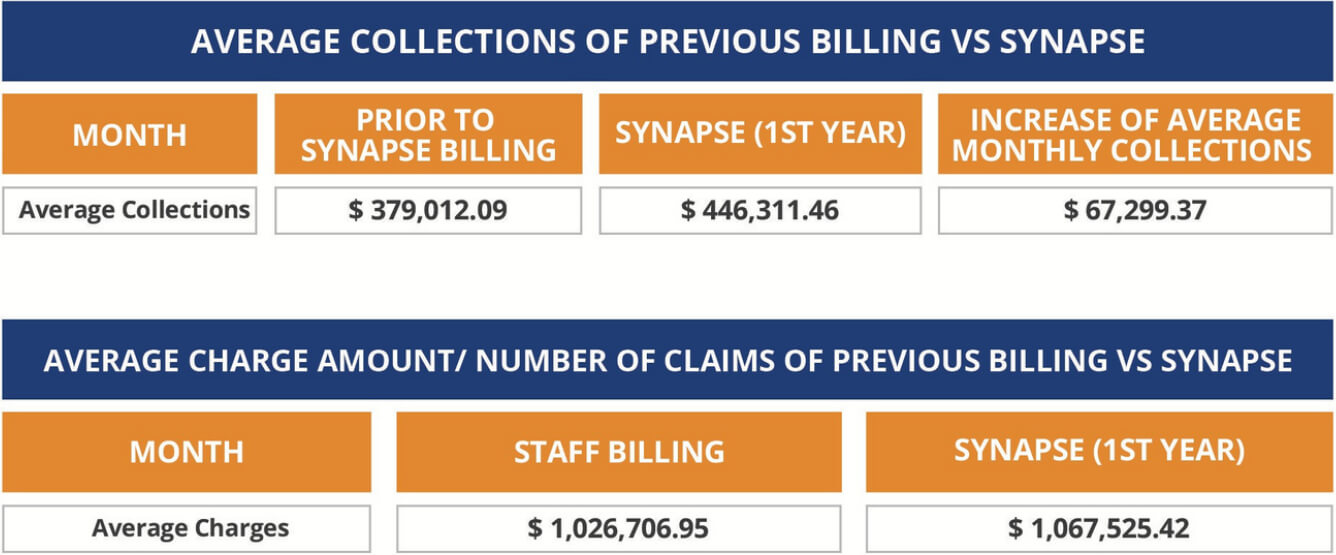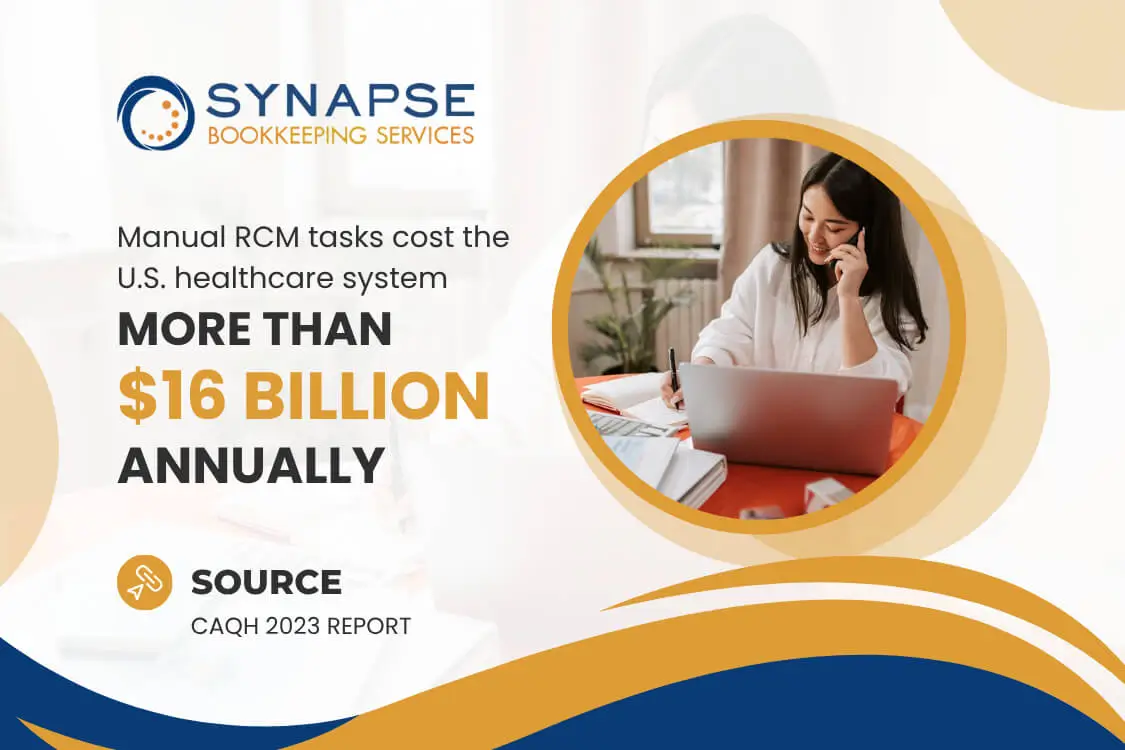The Strategic Role of RCM Trends in Modern Healthcare Accounting
Did you know that in 2023, healthcare spending accounted for 17.6% of the U.S. economy, and it’s projected to grow by over 5% annually, outpacing overall economic growth?
For healthcare providers, this means increased pressure to grow, remain compliant, and meet patient needs. However, with outdated systems, it’s easy to encounter billing delays, reporting errors, and missed opportunities to enhance revenue.
To keep pace with the rising complexity, many healthcare organizations are transitioning toward more innovative, technology-driven revenue cycle management (RCM) solutions. In this blog, we break down the latest RCM trends—from automation to AI—and explain how they enable faster reporting, cleaner books, stronger compliance, and real financial visibility.
Why RCM Now Anchors Healthcare Accounting
As healthcare businesses grow, their bookkeeping and accounting need to become more dynamic. Traditional billing tools, once sufficient for smaller practices, are now outdated. They often rely on manual processes, siloed systems, and limited reporting features that can’t keep up with today’s demands.
The result?
- Billing delays
- Inaccurate financial reporting
- Missed revenue opportunities
- Frustrated accounting teams stuck in reactive mode
Manual RCM tasks cost the U.S. healthcare system more than $16 billion annually, according to the CAQH 2023 Report. This staggering figure highlights the need for more innovative, technology-enabled solutions in healthcare finance.
This is where RCM plays an important role. A modern, well-integrated RCM system doesn’t just collect payments—it anchors the entire financial infrastructure by supporting:
- Stronger cash flow through faster collections and fewer denied claims
- More innovative pricing models by linking real costs with accurate, compliant coding
- Sustained profitability with more precise revenue projections and cost controls
Without a strong RCM foundation, even the best accounting teams can face month-end chaos, audit challenges, and inaccurate forecasts. That’s why modern healthcare finance teams now view RCM as both a compliance tool and a strategic lever for growth.
So, what’s next for RCM? In the following section, we examine the emerging trends that are reshaping how healthcare businesses manage their revenue cycles.
Top 5 RCM Tech Trends Transforming Healthcare Accounting
To meet modern challenges, healthcare providers are turning to innovative revenue cycle management platforms that incorporate accounting-focused technologies. These innovations don’t just support billing, they transform the entire finance function.
Trend 01: Automation
Fewer GL errors, faster closes
1. Automation for cleaner books and faster closes. 65% of healthcare CFOs are prioritizing automation in their finance transformation plans. Automation enhances RCM by eliminating manual, error-prone tasks and enabling faster, more accurate transactions.
For accountants, this means:
- Less manual entry, fewer errors in the GL
- Automated reconciliation between charges and collections
- Faster, consistent month-end reporting
By reducing human error and administrative overhead, automation enables finance teams to focus on strategy rather than repetitive tasks.
2. Cloud-based systems for real-time financial control. 80% of U.S. healthcare organizations use cloud-based RCM to achieve better billing accuracy, reduced IT overhead, and greater flexibility.
Benefits of cloud adoption:
- Improved accessibility and data backup
- Faster deployment with minimal IT infrastructure
- Scalability for growing practices and multi-location clinics
Cloud platforms also offer enhanced data protection and automated backups, which are particularly beneficial during audits or unexpected downtime.
Trend 02: Cloud-based platforms
Real-time access, audit readiness
Trend 03: AI & Data Analytics
Smarter forecasts, reduced leakage
3. Data analytics & AI for smart revenue projections. Approximately 46% of U.S. hospitals and health systems now utilize AI to enhance their revenue cycle operations. These tools help healthcare providers do more than just track numbers—they turn data into valuable insights.
With built-in analytics, RCM systems can:
- Spot billing trends and issues early
- Predict cash flow and highlight unusual patterns
- Identify claims likely to be denied
- Improve revenue forecasting and planning
These insights empower finance leaders to make faster, data-informed decisions while proactively addressing revenue leakages.
4. Patient-centered billing experience to reduce accounts receivable (A/R) and bad debts. With patients now responsible for 35% of provider revenue, outdated billing methods risk not just financial loss, but also patient dissatisfaction.
RCM platforms with patient-friendly features enable:
- Transparent, digital billing statements
- Mobile payment options and auto-reminders
- Integrated payment plans and real-time tracking
A smoother patient billing experience can lead to higher collection rates, reduced bad debt, and stronger patient trust, all of which contribute to a healthier bottom line.
Trend 04: Patient-Centered Billing
Lower A/R, improved collections
Trend 05: Blockchain
Secure, traceable transactions
5. Emerging technologies: Blockchain for secure transactions. The global blockchain in healthcare market is projected to skyrocket from $1.19 billion in 2023 to $4.7 billion by 2027, growing at a swift 68% CAGR. This indicates serious investment and confidence in its future. This is an up-and-coming technology in healthcare finance. It creates secure, unchangeable records that providers, payers, and patients can share.
Its growing popularity is driven by:
- Faster, automatic payments
- Fewer fraud and billing errors
- Better transparency and audit trails
While still new, blockchain has strong potential to improve trust and efficiency in RCM systems.
Real-World Impact: How Synapse Modernized RCM for a Multispecialty Clinic
A mid-sized multispecialty clinic was struggling with outdated revenue processes, including high A/R days, frequent billing errors, and delayed month-end closings, which were slowing down operations and hurting cash flow.
To address these challenges, the clinic partnered with Synapse Bookkeeping and Accounting, which implemented a cloud-based RCM platform that leverages automation and provides real-time data visibility.
Before onboarding, Synapse conducted a comprehensive review of the clinic’s documentation, coding, and billing workflows. This assessment revealed significant gaps, particularly in modifier usage and coding accuracy, both of which were directly impacting reimbursements and compliance. With targeted improvements in place, the clinic saw transformative results:
Key Financial Outcomes
$67,299.37 increase in average monthly collections
$807,592.44 in additional annual revenue
18% increase in collections vs. previous performance
$665,710.99 recovered from outstanding A/R
Modern RCM Workflows Implemented

Check out full report here.
By modernizing the clinic’s RCM, Synapse enabled the team to spend less time fixing errors and more time focused on patient care. Leadership gained clearer financial visibility, faster reporting, and better control over the entire revenue cycle.
Ready to Modernize Your RCM? Start with Synapse
Revenue Cycle Management has proven to be a strategic advantage for businesses today. When paired with technologies like automation and cloud computing, it becomes a robust framework for financial control, audit readiness, and sustainable growth.
However, implementing these changes can feel complex without the proper support. That’s where an experienced partner like Synapse Accounting and Bookkeeping comes in.
With deep expertise in healthcare finance and modern revenue cycle solutions, Synapse helps organizations streamline their accounting processes without disruption.
Automating manual workflows
Enhancing reporting accuracy
Ensuring compliance, Synapse makes transformation manageable
Sources:
NHE Fact Sheet; Lifted from
https://www.cms.gov/data-research/statistics-trends-and-reports/national-health-expenditure-data/nhe-fact-sheet
2024 CFO Agenda Operational Efficiency and Resiliency; Lifted from
https://deloitte.wsj.com/cfo/2024-cfo-agenda-operational-efficiency-and-resiliency-fe2e04f5
Patients as the new payer; Lifted from
https://www.coniferhealth.com/knowledge-center/patients-as-the-new-payer-five-opportunities-to-improve-the-patient-financial-experience
Global blockchain technology; Lifted from
https://www.globenewswire.com/news-release/2021/03/18/2195742/0/en/Global-Blockchain-Technology-in-Healthcare-Market-Gaining-Momentum-Projected-to-Reach-USD-4-720-96-Million-by-2027.html
CAQH Index Report; Lifted from
https://www.caqh.org/hubfs/43908627/drupal/2024-01/2023_CAQH_Index_Report.pdf

